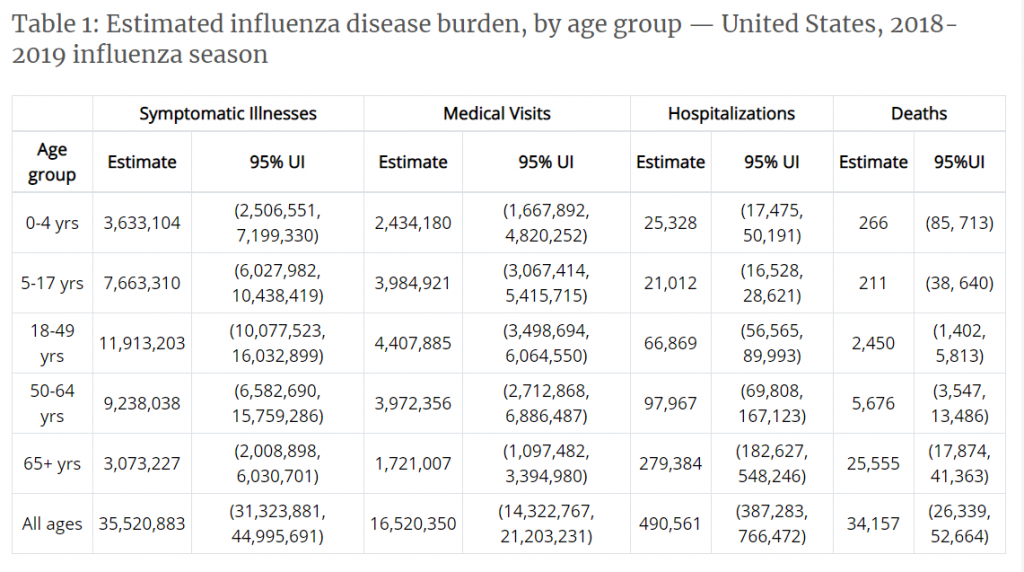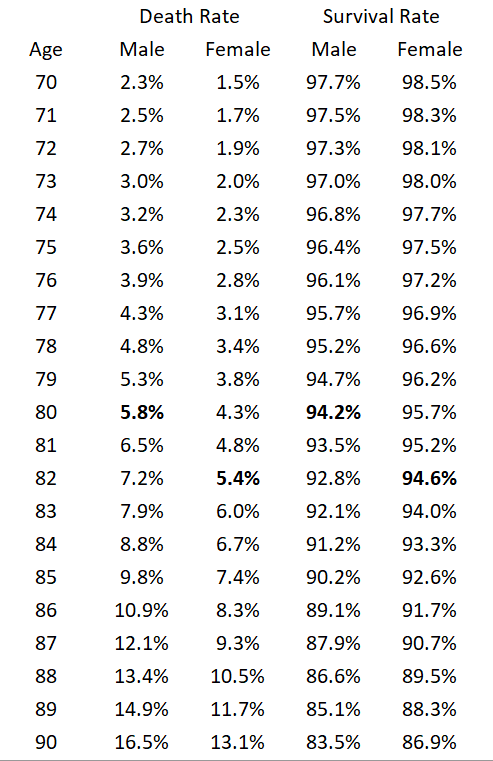By Benjamin Turner
Published on 2020-10-05 16:53 on LinkedIn
———————————————————————–
BANNED BY LINKEDIN ON 10-6-2020
Fraudspotters, LLC, takes no position with regards to this article. Furthermore, this article does not reflect the opinion of all employees.
However, in solidarity with our lead analyst, and in the interest of freedom of information on the Internet, we are posting the article below….
———————————————————————–
There seems to be a lot of buzz on the web about Covid-19 vs. the flu, so I thought I’d provide some thoughts.
Before I do, let me take a victory lap.
However, on September 10, 2020, the CDC itself came out with something similar to what I had written.
In fact, their numbers are a little more optimistic than mine, reflecting a nationwide estimate and not just New York. Here is a comparison; you can see we are very close for ages 49 and under:
So, how does this compare to the flu?
Well, the main difficulty is that people typically aren’t tested for flu antibodies to see if they had it, while there is a massive effort underway to understand who has had Covid-19.
For example, you, the reader have probably already had the flu in your life. Are you going to get tested to see if you had it in the last 12 months but were not symptomatic? And, if so, how reliable would such a test be?
But, you the reader, probably will know if you have covid-19, because you will likely have a blood test sometime in the future (if you haven’t already) to assess if you should get vaccinated.
So, given that you will find out if you had Covid-19, and you probably will find out if you have symptomatic flu, but probably not asymptomatic flu, how do your chances of survival compare: a) COVID-19 if you are infected vs b) the flu if you have symptoms?
I have already shown you the survival rate for COVID-19, so all we need is the survival rate for symptomatic flu. To calculate this, look up the chance of death for flu if you have symptoms.
Calculate survival rate by comparing the deaths to those with symptoms and the changing it from a death rate to survivor rate by performing 1-X.
Next, simply compare this survival rate to the Covid-19 infected survival rate.

You can do the same thing for the 2017-2018 flu year.
You can also do it for the 2019-2020 estimate of flu.
As you can see, if you are 49 years old, or younger, and you have Covid-19 (symptomatic or asymptomatic), your chances of death are not materially different than if you have symptoms of the flu.
For those aged 50-69, the difference is noteworthy, but also note that the flu age group is 50-64, whereas the Covid-19 age group is 50-69. There may be a big difference for those age 65-69 with less of a difference for ages 50-64.
And, there is a larger difference for those aged 70 and older.
94.6% survival rate vs 99.2% survival rate is noteworthy. Perhaps the improving treatment protocols will narrow this gap in the future.
Asymptomatic Flu
Everyone who reads this article asks about asymptomatic flu. Since we don’t really know how much asymptomatic flu actually occurs, the only thing I can do is provide estimates.
If we assume 16% of flu cases are asymptomatic, the numbers become (which probably doesn’t change any conclusions you have made in reading this article):
If we assume 75% of flu cases are asymptomatic (meaning there are 4X more cases–note this is an update to my article), then the numbers become.
I provide more details in the appendix.
I also think it is worth reiterating that a survival rate of 94.6% vs. a survival rate of somewhere in 99% range (the survival rates shown for 70+ years) is a pretty big difference. If you switch it back to death rates, we are saying about 5% of people who are over 70 who get covid-19 will die but only about 0.2% to 0.9% of people over 70 who get the flu will die.
On the other hand, people often believe it is a “death sentence” for older people who get Covid-19. That is not a valid belief and will become less and less so as treatments improve.
With regards to the comparative risk among individuals in the other age brackets, I will let you draw your own conclusions.
End of article.
————————————————————————————————————–
Appendix / Additional Thoughts
1) Asymptomatic flu.
You may be wondering how many people are asymptomatic with regards to the flu. I’m not sure if it is relevant. You have likely already had the flu in your life. Having asymptomatic flu simply means you got it again but didn’t notice. (This is different than the Covid-19 scenario–you have not had it in the past, and if you have it asymptomatically, you likely WILL know you had it when taking a blood test prior to being vaccinated.)
I found this to be the best summary of available data, and as you can see the results are so wide I did not know how to apply them to analysis. The paper appears to be saying that estimates range from 4% to 28%, 0% to 100%, and 65% to 85%. Seeing the wide array of estimates and knowing that all that it means is that you got it again but didn’t notice, I abandoned trying to incorporate asymptomatic flu data into my main article but provide some what-if analysis at the end.
Methods
We conducted a systematic review and meta-analysis of published estimates of the asymptomatic fraction of influenza virus infections. We found that estimates of the asymptomatic fraction were reported from two different types of studies: first, outbreak investigations with short-term follow-up of potentially exposed persons and virologic confirmation of infections; second, studies conducted across epidemics typically evaluating rates of acute respiratory illness among persons with serologic evidence of infection, in some cases adjusting for background rates of illness from other causes.
Results
Most point estimates from studies of outbreak investigations fell in the range 4%–28% with low heterogeneity (I2=0%) with a pooled mean of 16% (95% CI: 13%, 19%). Estimates from the studies conducted across epidemics without adjustment were very heterogeneous (point estimates 0%–100%; I2=97%), while estimates from studies that adjusted for background illnesses were more consistent with point estimates in the range 65%–85% and moderate heterogeneity (I2=58%).
2) How many people get the flu in a given year?
I found this to be a good source of info. It is saying that about 9% of people get it each year, except people over age 65 have a lower rate of infection at about 4%. The overall average is about 8%, which means the average person will experience symptoms every 11 to 12 years (even though we have a widely distributed vaccine program).
3) What was the survival rate in a given age for older people prior to Covid-19?
In the article above, I demonstrated that the CDC says the survival rate for someone age 70 or higher is 94.6%, meaning 5.4% die.
You may be wondering, what percentage of people age 70 or higher die in a given year due to age or other causes not related to Covid-19. I present the table below which shows the death percentage and the survival percentage by age for the USA in a given year computied using 2017 data. For males, living a year at age 80 is more dangerous than getting COVID-19 for the age group of 70+. The equivalent benchmark for females is age 82.
Finally, the end. BTW, if you read this far and enjoyed this information, please consider reposting it while you still can!
- March 2023
- November 2022
- July 2021
- May 2021
- April 2021
- March 2021
- February 2021
- January 2021
- December 2020
- November 2020
- October 2020
- September 2020
- February 2020
- December 2019
- October 2019
- June 2019
- May 2019
- August 2018
- July 2018
- February 2018
- December 2017
- October 2017
- September 2017
- August 2017
- June 2017
- February 2017
- August 2016
- July 2016
- May 2016
- January 2016
- November 2015
- July 2015
- May 2015
- January 2015
- May 2007
Other Articles by Benjamin Turner
Record Shattering Fire Season Am I Misunderstanding Something









